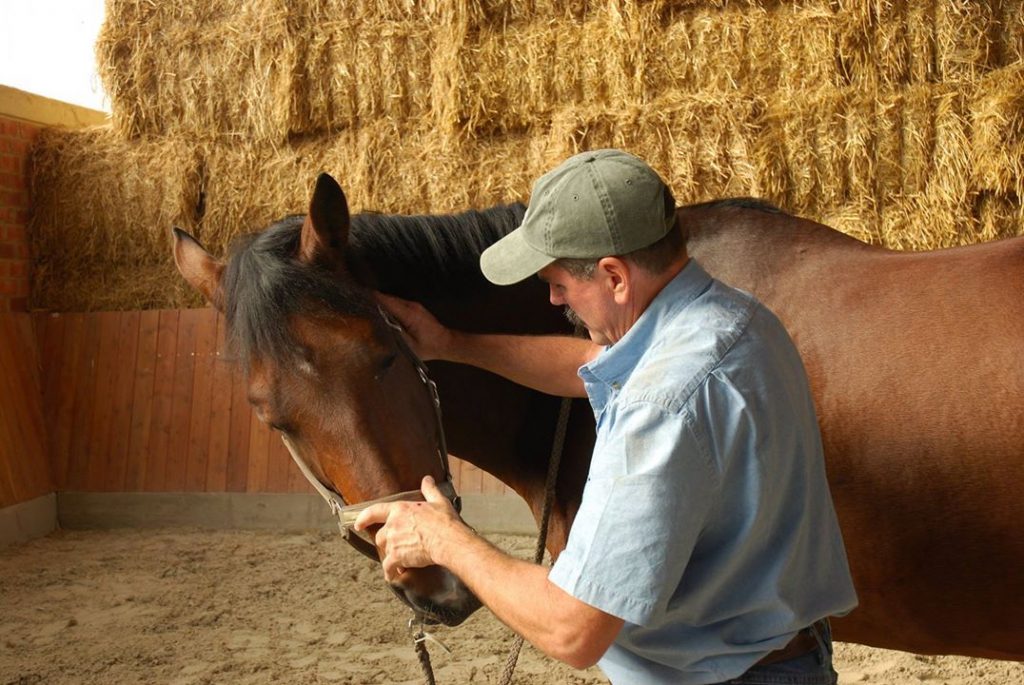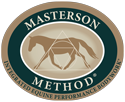
The Masterson Method of Integrated Equine Performance Bodywork comprises of two basic categories of techniques: those that release tension in situ, and those that release tension through range of motion in a relaxed state.
Releasing tension in the muscles and restoring flexibility and range of motion to the skeleton work together. Relieving tension in the major muscles that control a joint allows the joint to operate more freely. Simply asking for movement of a limb or body part in a relaxed state can release even more tension in the muscles and soft tissue that control that area of the body.
Whether you are using a technique to release tension in situ or to restore range of motion, how you “ask” the horse is fundamental to success. By using too much pressure or moving too fast, the horse will brace – either externally or internally – against the technique. If the horse is not in a relaxed state when you ask for movement of a limb there is likely to be bracing against the movement and tension is generated.
“Ask” is the key word here. We invite the horse to release tension. We can’t make him relax a muscle. We invite him to move a limb using a technique that will ultimately release tension. We never demand the movement. This use of non-resistance puts equine bodywork squarely into the realm of possibility for the average horse owner to learn.
This doesn’t mean we don’t use pressure with this Method. We do use pressure with some techniques, but the key is to yield when the horse yields, soften when the horse softens, and for the horse to release tension when we are under the bracing response.
For example, when you ask the horse to bend his nose toward you and he resists because the muscles of the poll and neck are tight, your first impulse is to pull harder and make him bend towards you. If you react to the resistance in the horse by doing more or harder, the horse will continue to resist, tense or brace. He may bring his head towards you, but he is still, to some degree, resisting, tensing or bracing. You cannot force a horse to relax. Only the horse can relax himself.
The Masterson Method teaches that when the horse resists, soften your hand(s) slightly. When the horse feels you stop pulling, he will stop pulling (let go), and you can continue the movement. When you give the horse nothing to resist, he will stop resisting, and you can immediately continue on with your move. You must train yourself to: feel the brace, immediately soften (which means stop asking for the technique), and wait until you feel the horse relax, and finally, continue on and ask for more movement.
If the horse is resisting because there is an injury or excessive pain in an area while doing any techniques that ask for movement, he will continue resisting in order to protect the area. In any case, whenever you meet resistance, soften. In this way you run little risk of aggravating a hidden injury.
Try this: When you pick up the horse’s foot and he pulls away, your first instinctive reaction may be to pull back. If you brace against him or keep pulling it causes him to continue to pull away. However, if you yield or ‘go with him’ just slightly, and you do it properly, he will almost always relax. This doesn’t mean you let go, only soften—or yield—to the resistance. Then, immediately ask him to continue with the movement. This takes practice, as it is counter-intuitive. It requires conscious control of yourself and often split-second timing in response to the horse’s behavior. But when you get it, you’ll be amazed at the results.
By “staying under the radar” the techniques of the Masterson Method are performed in such a way that the horse doesn’t brace against them. This requires feel and skill that may take practice to perfect, but if you begin with the basics you will get results immediately.
